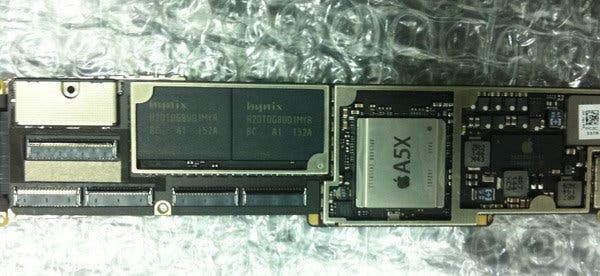In Theory: How iPad 3 Breaks the 1080p Barrier
Digital Foundry assesses the remarkable rumours surrounding Apple's next tablet.
It's that time of the year again. In the next calendar month, Apple is widely believed to be unveiling its third-generation iPad, and the engine at the core of the rumour mill is being cranked up to maximum warp in anticipation. Stalwart news site MacRumors has managed to acquire one of the new displays while Chinese forum WeiPhone has already hosted photographs of what many believe to be the iPad 3 logic board. Combined with other rumours currently circulating, a picture is beginning to form of the kind of device iPad 3 is and the level of power it is capable of delivering.
But first we need to assess the quality of the rumours in question. This close to release, we'd be inclined to believe that they're quite reliable. Apple isn't like a conventional games company: it keeps its cards close to its chest, and even before announcing a new product to the world it's already well into production. When it comes to mass-producing millions of units in a faraway country staffed by poorly paid workers, it's inevitable that leaks occur and across the years they have been growing increasingly accurate. Seemingly they're getting ever closer to home too - incredible pictures, highlighted by tech site MicGadget seem to be spy-shots taken directly from the iPad 3 production facility.
As it happens, most of these leaks are eminently plausible precisely because of the lack of surprises they offer. MacRumors says its OEM replacement screen confirms that the new iteration of the iPad offers a 4x resolution boost over the existing 1024x768 4:3 panel, offering up a mammoth 2048x1536 pixel count. The implications are immense: this would offer an increase in resolution of over 51 per cent compared to the 1080p plasma or LCD you may have in your living room or office, and within its 4:3 aspect ratio it will easily be able to display a full HD movie rendered in native resolution with real estate to spare. All this on what we would assume is the same 9.7-inch sized screen as the current iPad.
"An iPad 3 'Retina' display along the lines being rumoured would offer an increase in resolution of over 51 per cent compared to the 1080p plasma or LCD you may have in your living room or office."

Its pixels-per-inch count may well be lower than the iPhone 4's "Retina" display, but the screen is larger and likely to be held further away, so the overall impact of the mega-resolution should still be quite remarkable. The new screen brings with it obvious implications, not just on the make-up of the rest of the device but also on Apple's lucrative media delivery services. Right now, iTunes' definition of HD content is basic 720p, which would look rather miniscule rendered at native resolution on the new display. Rumours have been circulating for some time now that Apple has been moving up towards a so-called HD+ service, with content encoded at 1080p. Such a move makes plenty of sense, not just for the new iPad, but also for the completely integrated Apple TV displays that the company is said to be releasing at some point in the near future.
A "Retina" screen for iPad 3 also suggests that we should be seeing some significant upgrades to the camera in the new device. The iPad 2 only supports 720p movie capture at 30 frames per second - fine for the existing display, but upgrading this element up to 1080p for the new unit makes a lot of sense. Elsewhere within the tablet, we're looking at some serious architectural upgrades to maintain such a mammoth display with the kind of fluidity and response expected from an Apple product.
The Mysterious A5X - Quad Core or Not?
Here's where the leaked photo of the logic board and its mysterious A5X SoC (system on chip) comes under scrutiny. The notion that the main processor may not be called A6 has led many to believe that we are looking at an incremental upgrade of the existing chip found within the iPhone 4S and iPad 2, and there are concerns that a boosted version of the dual-core A5 simply won't have enough horsepower to maintain that incredible display. The important thing to factor in here is that Apple's definition of an incremental upgrade may well be quite removed from what we think it is.
The transition from A4 to A5 truly was a generational jump in terms of processing performance: core count on the Cortex A9 doubled, but the big news was that the SGX535 graphics core in the iPad 1 and iPhone 4 was given the boot in favour of brand new dual-core architecture from PowerVR maker IMG. The boost in CPU power between the chips was obvious, but it was in the graphics technology that we saw the biggest improvement. In truth, the original iPad's GPU - the same as that in the iPhone 3GS, but running at a higher clock speed - was inadequate for the much higher tablet resolution. A5 addressed that with the PowerVR SGX543 MP2 offering anything between a 4x to 9x improvement in power depending on the benchmark.
"An A5X doesn't necessarily rule out quad-core processing for iPad 3 - adding more CPU/GPU cores to the existing architecture would be a natural incremental upgrade."

An incremental upgrade for A5 makes much more sense because its architecture is inherently scalable: Apple can maintain that phenomenal resolution either by introducing a third graphics core (SGX543 GPU core count can be odd or even) and running all three at a much higher clock speed, or it well be the case that it will opt for a fourth core instead at the same speed. The current A5 is fabricated on the mature 45nm process by Samsung, and it's widely believed that iPad 3's processor will be produced at 32nm - so despite the increased power, it should still maintain the platform's enviable battery life.
Despite the worries that Apple will retain a dual-core A9 for the A5X processor, evidence suggests that we will be seeing a quad-core chip. BGR.com's leaked iBoot dump correctly identifies A5X's S5L8945X model number (A4 was S5L8930X, while A5 was S5L8940X) and is unequivocal about the number of CPU cores being utilised: four. Developer betas for newer iOS revisions have also seen support for quad-core CPUs, strongly suggesting that the OS was being tested on A5X. Whether the configuration will be four vanilla A9 processors or something more customised remains to be seen.
Will ARM A15 'Eagle' and PowerVR 'Rogue' Power the Next-Gen A6?
So if the new processor is so capable, why not name it A6? What is the actual significance of A5X? A look at the future of mobile technology puts everything into perspective. The march of technological innovation in this field is relentless; ARM is working on its next-gen A15 "Eagle" architecture, while IMG's "Rogue" GPUs are about to break cover. Adding cores to an existing design is incremental, moving to a new, more powerful, more capable technology is an entirely different ballgame.
"The focus for the iPad 3 reveal will almost certainly be on the most obvious upgrade: the new display, and how it improves what is already an excellent product."
iPad 3 will no doubt be highly capable, but let's put it into context with competing upcoming technologies: Sony's NovaThor chipset, in particular the 28nm A9600, represents the kind of generational leap in power we should expect to see in the full-blooded A6. A basic look at the raw specs suggests that this is the kind of power level that will finally see mobile technology match that we have now in our current gen home consoles, from a GPU perspective at least.
This is obviously exciting stuff, but it's unlikely that we'll see actual shipping products with this level of power until this time next year. The technology may be ready, but mainstream production of 28nm chips at good yields isn't really there yet. That being the case, the focus for the iPad 3 reveal will almost certainly be on the most obvious upgrade: the new display and how it improves what is already an excellent product.

